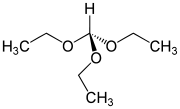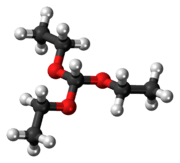Triethyl orthoformate
Triethyl orthoformate is an organic compound with the formula HC(OC2H5)3. It is a colorless volatile liquid. It is orthoester of formic acid. It is commercially available. The industrial synthesis is from hydrogen cyanide and ethanol.[1]
 | |
 | |
| Names | |
|---|---|
| IUPAC name
Diethoxymethoxyethane | |
| Other names
Triethoxymethane; Ethyl orthoformate | |
| Identifiers | |
3D model (JSmol) |
|
| ChEMBL | |
| ChemSpider | |
| ECHA InfoCard | 100.004.138 |
| EC Number |
|
PubChem CID |
|
| UNII | |
| UN number | 2524 |
CompTox Dashboard (EPA) |
|
| |
| |
| Properties | |
| C7H16O3 | |
| Molar mass | 148.202 g·mol−1 |
| Density | 0.891 g/mL |
| Melting point | −76 °C (−105 °F; 197 K) |
| Boiling point | 146 °C (295 °F; 419 K) |
| Hazards | |
| Safety data sheet | Fischer Scientific |
| GHS pictograms |   |
| GHS Signal word | Warning |
GHS hazard statements |
H226, H315, H319, H335 |
| P210, P233, P240, P241, P242, P243, P261, P264, P271, P280, P302+352, P303+361+353, P304+340, P305+351+338, P312, P321, P332+313, P337+313, P362, P370+378, P403+233, P403+235, P405, P501 | |
Except where otherwise noted, data are given for materials in their standard state (at 25 °C [77 °F], 100 kPa). | |
| Infobox references | |
It may also be prepared from the reaction of sodium ethoxide and chloroform:[2]
- CHCl3 + 3 Na+ + 3 EtO− → HC(OEt)3 + 3⁄2 H2 + 3 NaCl
Triethyl orthoformate is used in the Bodroux-Chichibabin aldehyde synthesis, for example:[3]
- RMgBr + HC(OC2H5)3 → RC(H)(OC2H5)2 + MgBr(OC2H5)
- RC(H)(OC2H5)2 + H2O → RCHO + 2 C2H5OH
In coordination chemistry, it is used to convert metal aquo complexes to the corresponding ethanol complexes:[4]
- [Ni(H2O)6](BF4)2 + 6 HC(OC2H5)3 → [Ni(C2H5OH)6](BF4)2 + 6 HC(O)(OC2H5) + 6 HOC2H5
Triethyl orthoformate (TEOF) is an excellent reagent for converting compatible carboxylic acids to ethyl esters. Such carboxylic acids, refluxed neat in excess TEOF until low-boilers cease evolution, are quantitatively converted to the ethyl esters, without need for extraneous catalysis. Ref. J.B.Paine III, J. Org. Chem. 2008, 73, 4929-4938. Alternatively, added to ordinary esterifications using catalytic acid and ethanol, TEOF helps drive esterification to completion by converting the byproduct water formed to ethanol and ethyl formate.
See also
References
- Ashford's Dictionary of Industrial Chemicals, Third edition, 2011, page 9288
- W. E. Kaufmann and E. E. Dreger (1941). "Ethyl orthoformate". Organic Syntheses.; Collective Volume, 1, p. 258
- G. Bryant Bachman (1943). "n-Hexaldehyde". Organic Syntheses.; Collective Volume, 2, p. 323
- Willem L. Driessen, Jan Reedijk "Solid Solvates: The Use of Weak Ligands in Coordination Chemistry" Inorg. Synth., 1992, Vol. 29,111–118. doi:10.1002/9780470132609.ch27